-
6 Benefits of Enrichment Classes for All Ages
Education doesn’t stop when the school bell rings or when graduation is over. In fact, everyone is constantly learning, whether that’s through a formal class or informal exploration. People who take a lifelong learning approach to life may seek out enrichment classes for personal growth, to build new skills, or connect with others in their community.
What are enrichment classes? Typically non-credit, they can cater to any age or interest of learners in your local community.
What are enrichment classes? Afterschool programs, adult ed classes, workshops at your local makerspace, lectures at a senior center, and educational offerings at a theater or museum can all be considered enrichment programs. Enrichment classes are non-credit and typically outside of core subjects like math and reading. They can cater to any age or interest; the common theme is that the majority of learners come from the local community.
Below, we explore 6 benefits of enrichment classes that community education programs can use in their marketing campaigns, to encourage donations, or to inspire your team by reminding them that they’re doing important work.
Benefits of Enrichment Programs for Your Community
Are you wondering why is enrichment important for students? Enrichment classes fill needs that for-credit courses and other educational programming just can’t. Enrichment classes also strengthen your community and your organization’s place within it. Here are 6 ways enrichment classes benefit learners and communities.
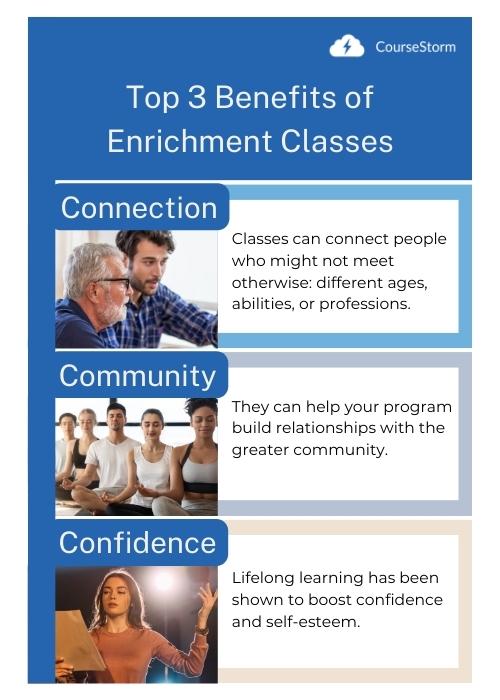
1. Connect people who might not meet otherwise
Enrichment classes have an amazing way of bringing people together. They might be students with different majors who would never cross paths otherwise, or they could be members of your wider community who work in different areas. Bringing these people together enriches everyone. It leads to lateral thinking, unconventional partnerships, and a sense of community connection.
An innovative program at the University of Texas at Austin called Lifelong Learning With Friends gives adult learners with intellectual and developmental disabilities access to the university experience through stimulating and fun post-secondary education opportunities. “Reverse inclusion” means that neurotypical UT college students learn alongside their neurodiverse peers.
2. Claim your place within a wider community
Enrichment classes also help your program build relationships with the wider community. When people in the community depend on your program as a source of education, they have tangible examples of the value you offer to the community. This makes them more likely to support, donate, and lobby on your behalf.
Many community colleges have begun offering non-degree credentials that address the needs of local employers and industries. Forming partnerships with local businesses is a win for everyone: the educational institution, learners, and the community.
3. Improve soft skills and confidence
Many learners are focused on how education can help them find a new job or earn a raise in their current one. But technical classes aren’t the only way to do that. Enrichment courses help learners improve soft skills. From creativity to communication, problem-solving to public speaking, enrichment classes present fun challenges that help learners improve their skills.
Lifelong learning has been shown to boost confidence and build soft skills like creativity and communication.
Learners don’t leave these skills in the classroom. They bring them out into the community. Plus, lifelong learning has been shown to boost confidence and self-esteem. It also gives people hope and purpose, which can help them face the stressors of life.
4. Prevent the dreaded “brain drain”
Enrichment classes can keep kids from backsliding during summer breaks. Research has shown that kids can lose an average of 20-27% of their school-year gains during summer vacation. Keeping them engaged and learning can help prevent some of these losses.
The same principle can help seniors in retirement. Research has shown that seniors can improve their cognitive health by learning something new. It’s more effective than just socializing. So your enrichment program can benefit both the oldest and youngest members of your community.
5. Give every learner the chance to shine
Traditional academic subjects may not be everyone’s idea of a good time. Students who struggle with math or reading may excel in classes focused on arts or performance. Those who hate sitting through a whole class period may blossom in a dance or gymnastics class. Offering a variety of types of classes invites more people into your learning community. Encouraging a more diverse community benefits everyone.
To get a better understanding of the different kinds of learning and where your program fits in, check out our free resource, A Complete Guide to Types of Learning and Why We Need Them All.
6. Bring in new students and keep existing students engaged
If your organization offers for-credit courses or diplomas, enrichment classes can serve as a lead magnet for these higher-investment programs. They give students a fun and accessible way to experience your program. Even offering a free course can pay off in the long run.
Offering enrichment classes can keep students engaged and attract new learners between sessions or semesters of for-credit courses.
Engagement leads to enrollment. If your organization offers semester-based learning or seasonal programs, you probably experience some enrollment melt between sessions. Offering enrichment classes can keep students engaged during the off-season so they’re more likely to re-enroll during the regular term.
Use These Benefits of Enrichment Classes in Marketing
Knowing the benefits of enrichment classes is one thing. Spreading the word about them is another. Help learners and community members see the value of your program by talking about these benefits. Not only could it help you sell more classes, it can also show your commitment to the community.
Subscribe to our blog for more insights and strategies for arts and enrichment programs. And don’t miss this post that shares data-backed tips for the best days to schedule classes and where to promote them: How to Market Art Classes to Fill Every Seat: New Data on Scheduling and Promotion.
-
The Best Class Registration Forms Achieve These 5 Vital Tasks
Online class registration forms can do more than gather information. They’re often your first direct communication with a student. You can use them as an opportunity to share information, better understand student needs, and tap into their insight. In short, well-designed class registration forms set the foundation for a positive student experience.
To achieve all that without overwhelming the student takes some smart decision making. You want to keep your forms focused and relevant, but still collect and share the information you need. Let’s look at the basic tasks every registration form must accomplish. Then we’ll share a simple course registration form template you can customize with class-specific questions.
What Should a Class Registration Form Do?
It’s easy to forget that class registration forms are a two-way line of communication. Collecting information from the student is only half their job. The other half is to provide the essential information a student needs to feel excited and prepared.
Make sure that your class registration forms accomplish all five of the following vital tasks.
1. Gather information about the student
The first function of a student registration form is to gather all of the information you need to know about them. This may include their name, date of birth, and their email address or phone number. For some classes, you might also need information about the student’s gender, allergies, or disabilities that might need special accommodation.
Be thoughtful about which information you really need. Gender, disabilities, and even date of birth might not be relevant in all cases. Show students that you respect their privacy by only asking for essential information.
2. Share details about class requirements or expectations
You can write a beautiful class description outlining everything students need to know, and they may still miss some details. If something is essential, include it on your registration form. Then add a box they can check to indicate that they’ve read and understood each item.
For example, the following paragraph packs in a lot of information:
“Family Float is a kayaking class for families. That means, children must be accompanied by a parent or guardian at all times. This is an immersive class, so you will get wet! Each participant should wear a swimsuit and bring a towel. Goggles and swim caps are optional. For your safety, you must wear your instructor-provided life jacket at all times while in the marked boating area.”
This might be a useful part of a class description, but it isn’t the best choice for your registration form. The friendly tone buries some of the details and students could easily miss important information if they’re reading quickly. They are more likely to come prepared if you list each requirement or expectation individually.
Like this:
- I understand that an adult guardian must accompany my child at all times during this class.
- Both my child and their adult will bring a swimsuit and towel to every class.
- I agree that both myself and my child will wear our instructor-provided life jacket at all times while in the marked boating area.
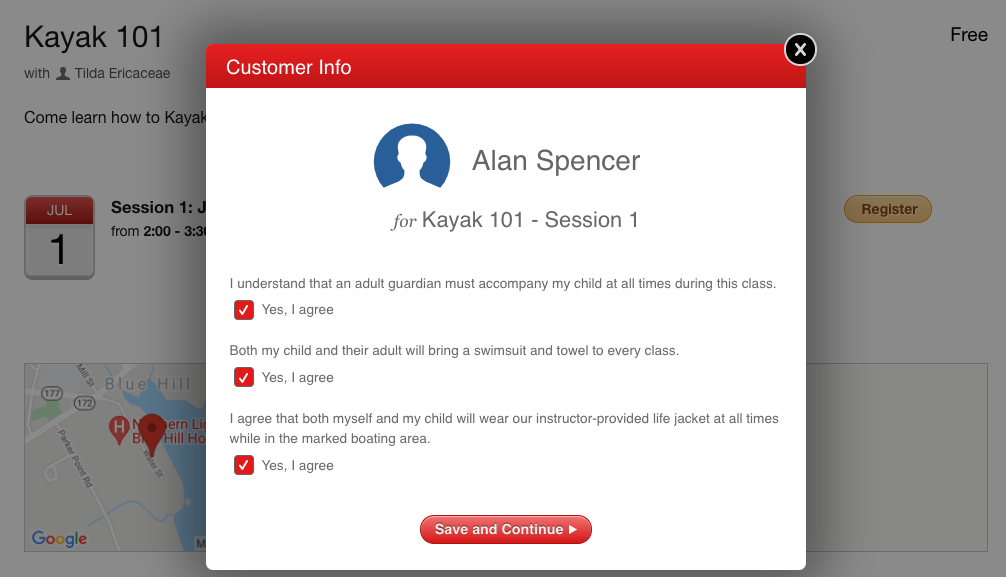
It’s easy to take this advice too far. Although you want to cover the essentials, you don’t have to include every detail of your course. For example, the part about goggles and swim caps probably isn’t vital to providing a safe and positive student experience.
If you do have supplemental information to share, you might want to include it as a linked PDF. Just keep in mind that students may not take the time to review everything. For the form itself, think about what information students will need to know in order to feel prepared for your course. Instructors can cover anything else during the class.
3. Include pricing information and ways to pay
Clearly state the cost and method of payment on your registration form. Link any price-adjusting options so the total automatically updates.
For example: If you’re hosting an Intro to Photoshop course you may offer a discounted license for the software. Some students may already have a copy and want to pay for just the class. In that case, you could include two pricing options. One for the class plus software and one for the class registration alone.
If you’re operating as a non-profit or providing free classes, you may also want to ask for a donation. Explain how your organization might use the donation. Wherever possible, include a suggested donation amount. A clear use and suggested donation amount can increase the likelihood that people will donate.
Here are some ways to put this into practice:
- Your $3 donation helps cover administration costs for this class.
- Foster a child’s creativity by donating $35 to meet the cost of class enrollment for one student.
- $10 pays for your class materials, helping us offer this class to more students.
4. Record consent for legal information or terms of use
If you need any waivers, legal releases, or consent forms, ask for them on your registration form. This lets instructors spend less time on legalities, and gives students a chance to read and review material.
Decide whether you need any or all of the following:
- Refund policy
- Photo release or recording permission
- Guardian consent for students under 18
- Statements about potential allergens or hazards
- COVID or other health policy statements
- Guidelines for using equipment or facilities
Even if you ask students to sign required documents when they arrive in class, include them with the registration form. This allows students to review them and ask questions ahead of time.
5. Offer opportunities to provide feedback
Feedback might be the most underutilized function of a class registration form. You don’t have to wait until a student has completed a class to start gathering their feedback. Opening a line of communication early shows students that you value their insight and are ready to listen.
Try adding questions like:
- How did you hear about this class?
- On a scale of 1 to 5, how easy was it to register for this course?
- What other classes would you like us to offer?
Limit yourself to one or two feedback questions that the student can answer quickly. Too many questions can make your form seem cluttered and overwhelming. Remember, this is just the beginning of the conversation.
A Class Registration Form Template Worth Copying
When you’re ready to start building your own class registration form, aim for simplicity. In some cases you may only need the student’s name, phone number, mailing address, and payment information. Students will appreciate that you stuck to only the most essential questions.
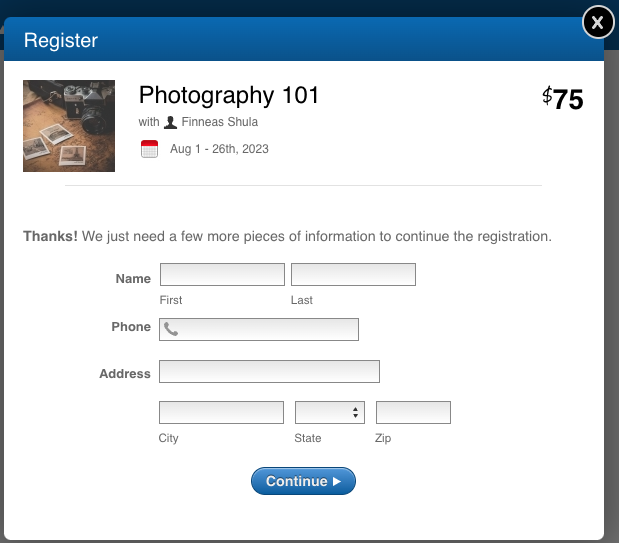
Some course providers fall into the habit of using one form for everything. So if one course requires special details, like allergy information, they include it in every form. The problem is that your forms quickly become bloated and complicated, which adds friction for the student.
It’s smarter to have a basic form template that you adjust for each class. When you customize forms to collect and share the right information, you offer a better student experience.
The checklist below will help you customize your forms. Use the optional fields only if you absolutely need that information to offer a quality class.
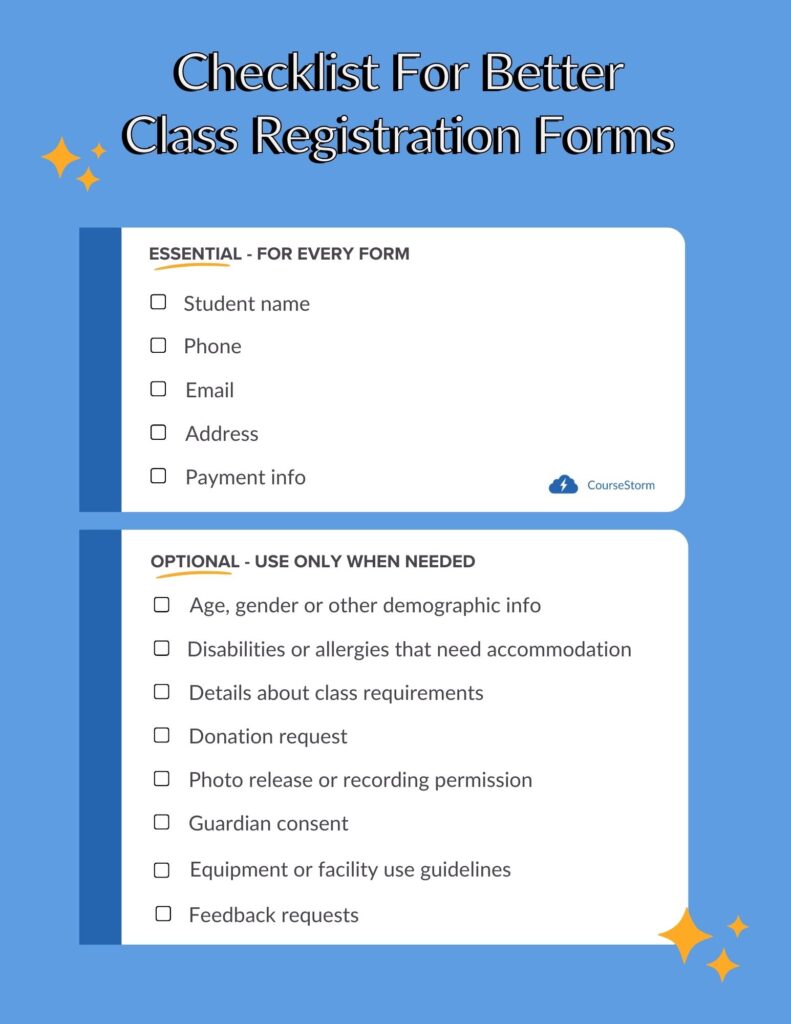
Make Your Class Registration Forms Easy to Use
Most importantly, your online registration forms should be accessible and easy to use. Make it mobile-friendly and use modern formats.
When forms are relevant, easy to read, and full of useful information, online class registration is easier for students. And that’s the beginning of a positive student experience.
That’s why CourseStorm offers built-in student registration forms and a range of customization options. We help you keep forms simple, while getting and sharing all the information you need to make a class successful. Contact us to learn more, or start your free trial and test the forms out yourself.
-
How a Clear Refund Policy Can Encourage More Registrations
No class provider wants to issue a refund to students. You want your classes to happen as scheduled and for students to be satisfied with the experience. But when weather, illness, or other circumstances disrupt the best-laid plans, it’s smart to have a clear refund policy. It lets both students and staff know what to expect.
We’ll show you how to write a clear policy that improves the student experience and makes life easier for your staff at the same time. We’ve even created an example refund policy that you can copy and customize to fit your needs.
Why You Need a Clear Refund Policy
Well-written refund policies are vital for any business providing services to the public, that includes course providers. A refund policy establishes expectations for both your business and customers and can protect you from potential financial losses and liability.
A clear refund policy lets students know what to expect if they need to cancel a registration and can protect you from financial losses and liability.
Your policy lets registrants know what to expect if they need to cancel a registration. Having a signed or virtually acknowledged refund policy can also help you win a credit card dispute known as a chargeback. When your policy is clear, students and registrants can work with you directly without getting credit card companies involved.
Example of a Clear Refund Policy
Let’s start with a solid example of a clear refund policy. This example covers the common reasons you might cancel classes, as well as reasons students might need to cancel. It explains common situations and how you’ll handle refund requests.
Note that we are registration software providers, not lawyers, so this isn’t legal advice. It’s just an example of a clear policy you might use as a starting point.
Example Refund Policy
This refund policy covers class cancellations and refunds for registered students. By registering for classes, you indicate that you have read and understand this policy.
- Weather-Related Cancellations:
We may sometimes choose to cancel classes if severe weather makes attendance unsafe for students or instructors. If this happens, we will notify you by phone or email. You will receive a full refund or credit toward an upcoming class if we cancel due to weather.
- Illness and Health-Related Cancellations:
If an instructor is ill and unable to teach as scheduled, we may bring in a substitute or cancel the class. If a class is canceled due to instructor illness, we will notify you by phone or email. You may choose to receive a refund or credit toward an upcoming class if we cancel due to instructor illness.
- Insufficient Enrollment:
If a class does not meet the minimum enrollment required to run effectively, we may have to cancel or reschedule it. Participants will have the option to transfer to another class, receive a credit, or request a full refund.
- Personal Cancellations:
If you cannot attend a class, you must notify us 7 days before the class start date to request a refund. An administrative fee of 10% will be deducted from the refund amount. If you cancel fewer than 7 days in advance, you will not be eligible for a refund.
- No-Shows or Missed Classes:
Refunds will not be provided for no-shows or missed classes without prior notification.
- Refunds Requests and Processing:
You must submit refund requests by email to refunds@myprogram.com. Refunds will be processed within 14 business days after we receive the request. If you paid by credit card or online payment system, the refund will be issued back to the original payment method. If you paid by cash or check, refunds will be provided by check.
We strive to be fair to our students while ensuring the smooth functioning of our programs. Please contact refunds@myprogram.com for any questions or concerns related to our refund policy.
You can adjust this policy to meet your needs. You might want to add or remove items depending on the kind of classes you teach.
How to Write a Clear Refund Policy
The example above can help you write a clear refund policy for your program. Whether you use our language or write your own, keep these best practices in mind.
- Be concise. People tend to breeze over terms and agreements when registering. Keeping your policy brief will increase the chances that your registrants will read it. Your refund policy shouldn’t be longer than one page.
- Use plain language. Legal jargon might make your refund policy sound official, but it won’t make it clear. Try to write in plain language an 8th grader could easily understand.
- Write one policy for all classes. Your refund policy should be standard across all of your classes. Consistent rules make it easier for students to remember and apply your policies.
The Best Refund Policies Include These 4 Items:
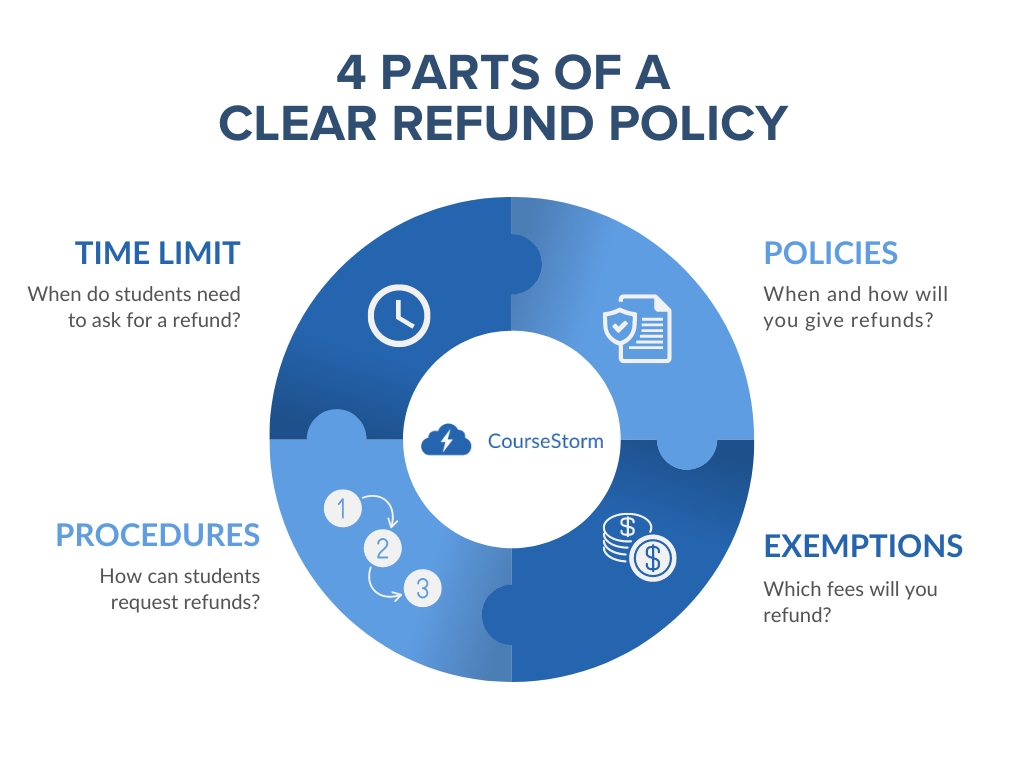
Your refund policy should clearly outline what students or registrants can expect. That means it should cover all common situations as well as the procedure for requesting and processing refunds. Check that your refund policy includes these 4 items:
- Time limit for refunds. Be clear about your refund timeframes. For example, “no refunds after the first day of class” or “refunds must be requested 48 hours before a class begins.”
- Policies for class cancellation. There are multiple reasons why a class may be canceled. Cover the most common ones (weather, illness, low enrollment) so students know what to expect.
- Specific exemption information. Tell students which fees you will refund in each situation. For example, some programs offer a special exception if the student gets sick. Others may refund a materials fee but not the class fees.
- Clear refund request procedures. Describe the procedure that a registrant must follow in order to request a refund. Link to necessary paperwork and tell them exactly where to send it or whom to contact.
It’s also good practice to review and update your policy yearly. If you make changes, email existing students and let them know.
How to Share a Refund Policy
A clear refund policy is only useful if your students know about it. To make sure your registrants see your refund policy, share it in at least one of the following places:
- Your main website menu
- As a link in the footer of your main website
- As a link at the bottom of each course description
CourseStorm customers can share their refund policy in two useful ways: as a link on their CourseStorm site or as a waiver on their class registration form.
If you’re a CourseStorm customer, you can share your refund policy in two other useful ways. Adding it as a link in the intro text of your CourseStorm site can make it more visible. You can add it as a waiver on your class registration form. The waiver should include a checkbox indicating that the student has read and agreed to the policy.
Share Your Policy Internally
Your staff should also get a copy of your policy so they are ready to answer questions from students. Sharing the policy internally ensures that everyone is following the same rules. If you decide that certain staff members should have the power to make exceptions, tell them where to document those exceptions.
Clarity Makes Registrations Simple
Nobody wants to issue a refund, but it’s good to know you have a clear policy in place when needed. Your straightforward approach will help students feel more confident in their purchase. Staff members will save time by having a clear policy to reference. Your program might even save money by avoiding chargebacks and other headaches.
Simplifying the class registration process is something we know a lot about here at CourseStorm. Our online class registration and payment software simplifies everything from policy sharing to group registrations, so your students get a seamless registration experience every time. Try a free trial for yourself, or contact us to learn more.
-
Educating Arts Educators: 6 Ideas for Professional Development
All educators benefit from professional development. Teachers in the arts are no exception. In fact, art teacher professional development serves a double purpose. It helps professionals hone their teaching abilities while also improving their artistic skills.
Making art and teaching it are two separate but related skills. The best artist-educators find time for their own creative pursuits and also take opportunities for teacher professional development.
Fortunately, there are organizations that offer specialized workshops and classes for art teachers and other arts educators. We’ve rounded up some resources and suggestions for where to find these opportunities so art teachers can continue to work on their craft while supporting their students.
-
The Best Course Evaluation Questions and How to Write Them
Course evaluations can help make your classes better. They collect meaningful data about students’ experiences, what they learned, and how they felt about the class. You can use that information to improve your courses and make them even more attractive to future students. But getting useful and honest feedback from students takes some finesse.
Good course evaluation questions invite students to share their real opinions. They offer insight into the student’s experience so you can make changes based on data, not guesswork. Each question must be carefully written and designed with a specific aim in mind. Here is some actionable advice you can use on your next class feedback survey.
-
Course Marketing Made Simple With Ideas From Author Leidy Klotz
Welcome to the first post in our blog series reflecting CourseStorm’s core values: Simplicity, Growth, and Helpfulness. Our mission is to streamline access to education to empower personal growth through our impossibly simple course registration software. In this post, we’ll be discussing the value of simplicity.
If you don’t think of yourself as a marketer, and sometimes even if you do, course marketing can feel like a complex task with too many moving parts. You might find yourself wishing for marketing made simple—a way to do less, but still get great results. That is the very theme of the book Subtract: The Untapped Science of Less by Leidy Klotz.
Through research and anecdotes, Klotz explores how subtraction can help us address everything from climate change and racism to city planning and play. If subtraction could help in all those areas, couldn’t it also apply to course marketing? Let’s find out.
-
5 Ways Art Teachers Can Balance Teaching and Creating Art
Whether you teach painting, drama, music, creative writing, or anything else in the arts, it’s sometimes difficult to find time for your own artistic pursuits. Art teachers spend so much time and energy teaching art to their students that there may not be much left over for their own work. But your work as an artist is valuable to both you and your students. It keeps your creativity sharp and fuels your passion for the subject.
Fortunately, there are ways for artist-educators to carve out time for their art. From crafting a well-structured schedule to harnessing inspiration in the classroom, we explore five ways you can integrate teaching art and your own personal practice of making art.
-
Fun Icebreakers for Adults to Use in Classes, Meetings, and More
Even if you’re not familiar with the term “icebreaker,” you’ve likely participated in one. An icebreaker is simply a question or activity that helps “break the ice” between strangers and encourages people to open up and talk to each other. Icebreaker examples include an impromptu “Where are you from?” while walking to class, or a scheduled team-building exercise at work.
Icebreakers can be especially useful in classes for adults, since grownups often do not interact as easily as children do. Find out about different types of icebreakers, examples of in-person and Zoom icebreakers, some tips to help icebreakers run smoothly, and what to do and avoid to make sure your icebreakers are inclusive.
-
What’s a Brand Promise and Why Does Your Education Program Need One?
Geico promises you will quickly save 15% or more on car insurance. Walmart assures you that their low prices help you live better. Canva claims their online graphic design platform makes it easy to create professional designs. These companies have built reputations around their brand promise—their commitment to their customers.
Your organization should have a brand promise too. Being able to articulate what makes you stand out from your competitors and what students can expect from your program is critical to building a successful brand and establishing long-term student loyalty. We’ll share the steps for finding your brand promise and offer some examples to help get you started.
-
How Theaters Can Boost Enrollment in Performing Arts Classes
Increasing class enrollment can be a challenge for any course provider. It might be particularly complicated for theaters with arts education programs. The marketing plans and workflows you have in place for performances don’t necessarily translate into functional course enrollment tools. If your goal is to enroll more students in your performing arts classes in 2023 and beyond, this post is for you.
Many theaters are just returning to normal programming after a tough few years. Maybe you’ve returned to entirely in-person events, or maybe you’ve found that online learning and events still add value for your audience. Our State of Informal Learning Report found that nearly a quarter of students still prefer online classes in 2022, even after the dramatic spike during the pandemic has started to recede. Either way, if you’re still working toward your enrollment goals, these strategies can help you register more students.
